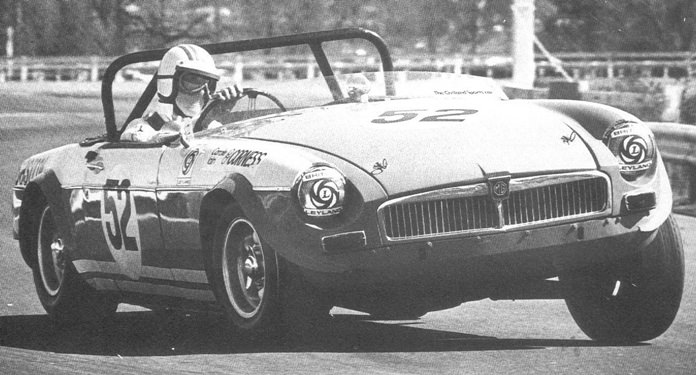There are many claims for the ‘fastest’ this or that, but I can verify this particular one.
According to British Leyland, the fastest MGB in the world in 1971 raced in Australia, competing in the Prodsports class and was a member of the British Leyland Works Team known as the Young Lions.

Fastest MGB in the world was a big claim that is for sure, but whilst impossible to confirm (or deny), it probably was. This car, known locally as “Super Bee” had lap records all over Eastern Australia, with one lasting eight years. It was faster than the 2 litre Autodelta lightweight Alfas, it was more highly developed than the British Leyland backed MGB’s in the UK and in Australia set similar lap times to the V8 Mustangs of the day. Super Bee was a brute, and I should know because I built it and I was the driver.
If its sheer speed is not enough, there is another amazing facet to the saga of Super Bee, because after I sold it, it spent 30 years sitting in a shed until it was purchased by an enthusiast in 2008 and restored faithfully to its condition as it was in the early 1970’s. The world’s fastest barn find?
However, to understand this Aussie MGB, a little of its history is required. An MGB shell was found in one of the local wrecking yards. This car had been stolen, stripped and then set fire to, but the damaged shell was just perfect for my needs. It was a lightweight, as the fire had removed all the sound deadening insulation, and all the lead from the body seams had melted and run away.
We built the entire car in six weeks, but it was an exhausting six weeks working 6 p.m. till midnight Monday to Thursday, then all night Friday through to Saturday then continuing after a break Saturday 6 p.m. until 10 p.m. Sunday was the day of rest, but nothing of biblical significance. It was just sheer exhaustion.
My basic engineering knowledge came from reading as many books as I could lay my hands on, and that extended to re-working the front suspension geometry to get the lower wishbones and the steering rack parallel to each other and the road. We bent the steering arms at a friend’s garage, and just hoped we hadn’t weakened them. Heavier front springs were sourced from the local spring works and the valves in the Armstrong shock absorbers were turned upside down and screwed into the shocks. At the rear, the bottom two leaves were put on the top and anti-tramp bars fitted.
The chap next door was tired of all the noise each night and came over to complain, and it turned out he was a spray painter. He soon worked out that the sooner we finished this project, the sooner he would get a good night’s sleep, so he came and prepared the body and sprayed the car in a Wildfire Green color. I think this was the cheapest paint he could get. The bonnet and boot had been made in fiberglass, using the road car for the molds.
After a very promising first season, where the MGB was quicker than all the other MGB’s racing in Australia and the car became known as Super Bee. We were approached by British Leyland with an offer to join the British Leyland Works Team, but they wanted the car to look a lot better than it did, and on retrospect, it was very rough. We said yes, if they could help us bring the car’s appearance back to scratch. It was agreed that we could take the car to the BL workshop in Brisbane.
There it was painted in corporate colors and in 1970 was one of the top runners in Prodsports. For 1971 we built a twin cam engine for the car and this really produced some horsepower. It produced lap records all over the eastern seaboard of Australia, but had a finishing record of only 50 percent!
The saga does not end there, because at the end of 1971 British Leyland was pulling out of Australia and the Works Team was disbanded. On top of that, CAMS outlawed the top six cars in Prodsports by placing restrictions on the specifications on what had been the best, closest racing at the time. I put Super Bee in the shed and went Moto-X racing instead.
In 1974 I was approached by twin brothers (John and Peter McCabe) who wanted to purchase Super Bee. I sold it, less engine, with them putting a pushrod engine back in. Super Bee’s first resurrection.
Unfortunately Peter McCabe was killed driving another MGB and Super Bee was put in the shed at the request of the twin’s mother. It stayed there, destined never to come out.
Now fast forward 30 years and John McCabe died early and his widow put Super Bee up for sale and it was purchased by an enthusiast, Ian Rogers, who felt that an MGB with that history should be restored.
Ian Rogers then embarked on what was probably a bigger restoration than he had imagined. Cars which sit in sheds for 30 years do not drive out after filling the tank and charging the battery! Ian found me in Thailand, and since there was not one bolt in that car that I hadn’t personally tightened, I was able to explain some of the stranger items in the car, and why they were there.
However, it did run out of Ian’s workshop in 2010 and he has been racing it in the historic class in Queensland. John Campbell, the chap who had helped me build the first iteration of Super Bee has seen it and wrote to me saying, “It was like going back 40 years. The restoration is exact.”
I have to say that it makes me very proud to have been part of the saga of Super Bee.




